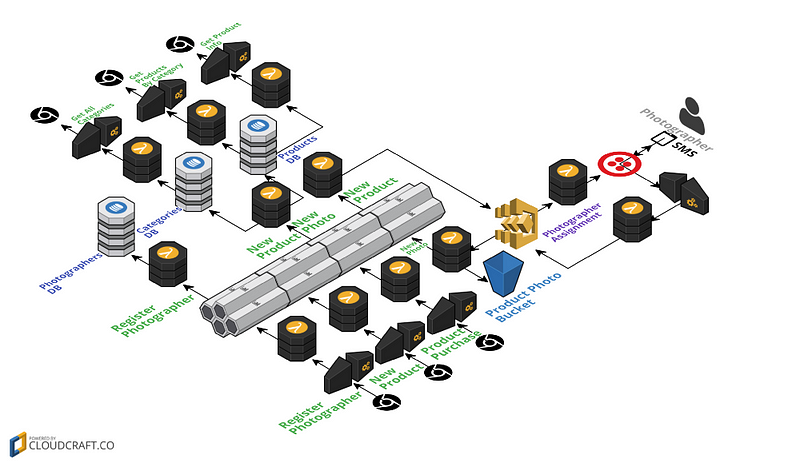State of Serverless
Some quick thoughts from Serverlessconf, Austin in April 2017
I wanted to take a bit of time to write up what I thought were some of the main themes I noticed at Serverlessconf Austin. I learned a lot and met some great people, so thanks a ton to A Cloud Guru for putting on the conference. In addition, I got a ton of new t-shirts, ate a few gourmet donuts, and enjoyed Austin by visiting some friends and family. Anyway, here are some notes/thoughts.
What is Serverless?
Everyone at Serverlessconf was still defining what Serverless is. The consensus seems to be:
- Serverless is more than Functions As A Service (FaaS). It includes also other services such as database, authentication, API gateway, orchestration, or more domain specific services, for instance video transcoding as a service or cognitive services, where you are not managing any of the infrastructure related to the service.
- Serverless means (close to) 100% utilisation. This is in contrast to PaaS, where applications either operate at a given scale, or scale more slowly and there will be scaling overhead (unused instances sitting around waiting for requests). In contrast, when serverless services are unused, they cost nothing, but can (almost) instantly scale to millions of users if necessary, and the cost is directly related to the usage.
Event Driven instead of Data Driven
Another big theme that came out was that serverless applications enable architectures that are designed around events rather than around data. Subscribing applications to an event queue is a nice way to manage service communication, since you can easily add new services onto an existing queue to modify or add functionality, as opposed to baking data flow directly into applications, which introduces strong coupling.
Rob Gruhl presented some interesting work from Nordstrom where they are using a central unified event log to manage data flowing through their retail systems. Applications can produce and consume events from the stream. Any application which needs a performant view of current state builds its own state database (a view database) by subscribing to the event stream. Then it can service requests based on its needs. Likewise, these applications can produce events for other services to consume. This completely removes the need for a core database system which maintains some centralised state, improving scalability and decoupling between microservices.
Their demo application, Hello Retail, provides a way for photographers to take photos of new products. When a new product is added, the system selects a photographer from its list of known photographers and sends them an SMS requesting a new photo. When they send a message back (via SMS), the system processes the photo, adds it to a photo bucket, and registers it as a photo for the product.

Hello Retail Architecture by Nordstrom (from https://read.acloud.guru/announcing-the-winners-of-the-inaugural-serverlessconf-architecture-competition-1dce2db6da3)
See their Hello Retail project on github for more details.
Srini Uppalapati from Capital One opened up about Capital One’s core banking systems which they are both transitioning to the Cloud and heavily leveraging serverless offerings. They are migrating their core transactions system in two steps:
- Remove read load from their mainframe systems by adding shims to their mainframe to stream events to databases in the cloud which are then consumed by user facing applications and data scientists.
- Remove the write side from consumer applications, moving core business logic to the cloud.
They are code complete on step 1. Srini shared their architecture which involves using AWS Lambda for processing batches of old data and real-time events coming from their mainframes and pumping the data into S3 for archiving, DynamoDB for consumer applications, and Redshift for analysis.
It is extremely interesting how both at architectural and application levels, using first class events is a powerful way of decoupling logic from state: one way data flow makes things simpler to reason about. At the application level we have ELM architecture and React/Redux as core examples, and now in the cloud we can use cloud functions combined with a core event stream to create functional cloud applications that operate at scale.
Enterprises are buying in quickly
As mentioned above, Nordstrom and CapitalOne are doing key work in proving out Serverless in the enterprise space. I was surprised how many other big enterprises were mentioned at Serverlessconf, and how they are quickly buying in to serverless technology.
I think one element that has led them to jump onboard is that many of them are already in the journey of moving to the cloud, and since their cloud provider has serverless offerings, they can drastically reduce their costs by going serverless. For instance, Srini from Capital One shared that they had made significant cost savings for moving to serverless in the cloud. Apparently their transactions hub costs ~$95k per year to run (which is insanely low given their customer base: ~45 million accounts).
To serve this enterprise appetite, all the cloud providers are also buying in heavily to serverless offerings in addition to AWS. The other cloud providers (Google, Microsoft, and IBM) demo’d their FaaS and serverless orchestration offerings.
Modern Agile enabled by Serverless Computing
Mike Roberts gave an awesome talk about how serverless lets app developers think more about their customers and less about technical problems. Modern Agile (Make People Awesome, Deliver Value Continuously, Make Safety a Prerequisite, Experiment and Learn Rapidly) is easier with serverless, since developers no longer have to solve problems that have been solved a million times before, by many other developers (how to do authentication, how to scale, etc…) and allows them to focus on delivering customer value. Time to go to production can now be measured in hours, not days or weeks. Since
“Most of our ideas suck” — Jeff Patton
we should try as many ideas as possible. Thanks to serverless, trying things is cheap!
In this vein, there were quite a few serverless success stories, not the least of which being Marcia Villalba talking about moving Toons.tv to serverless. They garnered significant cost savings by rethinking their architecture for the cloud. They did all that with a small team of engineers who were unfamiliar with serverless technology in a matter of months. She attributed a lot of their success to weekly workshops to get everyone on the same page about this new technology and proof of concepts for testing out new stuff.
Tools are still catching up
There was a general consensus that the tooling is lagging behind the cloud provider offerings. Florian Motlik complained extensively about how the AWS cli is immature. Other cloud providers have similar issues, in that they have invested heavily in the serverless runtimes but have neglected the tooling in the areas of deployment, monitoring and local testing.
This means basically any interaction you have with the cloud providers will be through third party tools, e.g. no one does serverless deployments with the AWS cli, mostly they are using frameworks that abstract the rawness of cloud provider interfaces into a simple application level framework for deployment (see, the serverless framework, claudiaJS, and zappa for starters).
AWS have released the Serverless Application Model (SAM) to try to address this. SAM is an abstraction layer on top of CloudFormation which makes creating Serverless Applications significantly simpler, however, the AWS cli is still immature (in my opinion).
Monitoring and debugging were also two areas that people felt are lacking in serverless applications, specifically when dealing with event based architectures (“My functions aren’t firing and I can’t tell why!”, and “Why can’t I live debug a running serverless function??”).
I’m not complaining about the lack of interactive debugging, since it is probably an anti-pattern, but if you are, Microsoft now has live debugging for Azure cloud functions via Visual Studio or Visual Studio Code (although the demo made it look a bit flakey). If you want to avoid interactive debugging, write unit tests.
Also, all the cloud providers are working hard on monitoring. Amazon X-Ray looks like a really solid monitoring option which integrates with the AWS SDK to provide live graphs and analytics of your integration points — a living architecture diagram. This pretty much comes for free if you use the AWS SDK for your service calls.
Another discussion point was that teams are still searching for the best patterns for developing serverless applications. Traditionally, it is easy to understand the domain of a particular application, because it is contained within a single server instance. You can spin up a local instance, stub any dependencies, and do some local exploratory testing as you are developing. However, with serverless development, often you are tightly coupled to the cloud provider (especially as services get smaller), and it is necessary to actually deploy your application (which might involve multiple cloud components) in order to test whether it is working end to end, even during development. There is a lot of demand for being able to do local exploratory testing, but as yet there aren’t any good patterns for how to isolate the piece of your application under test — it is common to end up with some frankenstein test application where pieces are running both locally and on the cloud. Some options in this area are the Atlassian AWS Local Stack which provides a fully functioning AWS stack on your local machine. Still, knowing why to use this versus just deploying to a development environment is still something under debate.
Serverless Orchestration
One of the issues with serverless computing that has been raised is the difficulty of orchestrating large numbers of lambda functions to create data pipelines in the cloud. Using event streams is one way of connecting lambda functions together, however there is often the need for more advanced functionality such as wait conditions or parallelisation.
Both AWS and Azure demo’d their serverless orchestration offerings: AWS Step Functions and Azure Logic Apps. Both of them look intriguing.
Azure Logic Apps has over 250 built in connectors to other Azure products as well as third party products. While I am suspicious of fancy user interfaces, in this case it is backed by a json scripting DSL, and they gave a great demo, linking live tweets to a sentiment analysis service within Microsoft and then producing a live feed of twitter sentiment around a certain topic… all in the space of a 45 minute demo (with some copy and pasted code).
While I am unsure how these workflow orchestration services will be used in a reliable way (how do you test them and deploy them?), I think they will become a part of the serverless landscape.
I am interested to see how these workflow services evolve into fully functioning platforms. Why must we script in a json DSL when we could have a better language (think Javascript or Swift) compile down to an ‘AWS Cloud Machine Language’, which is then run directly on some abstracted compute layer. AWS would then manage all the underlying servers and state without any restrictions around maximum run times or memory, where you pay exactly for the usage you need

如果这篇文章帮助到了你,你可以请作者喝一杯咖啡



